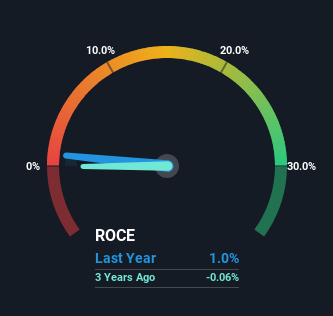These Return Metrics Don't Make Bajaj Hindusthan Sugar (NSE:BAJAJHIND) Look Too Strong
When it comes to investing, there are some useful financial metrics that can warn us when a business is potentially in trouble. Typically, we'll see the trend of both return on capital employed (ROCE) declining and this usually coincides with a decreasing amount of capital employed. This indicates the company is producing less profit from its investments and its total assets are decreasing. In light of that, from a first glance at Bajaj Hindusthan Sugar (NSE:BAJAJHIND), we've spotted some signs that it could be struggling, so let's investigate.
Return On Capital Employed (ROCE): What Is It?
Just to clarify if you're unsure, ROCE is a metric for evaluating how much pre-tax income (in percentage terms) a company earns on the capital invested in its business. To calculate this metric for Bajaj Hindusthan Sugar, this is the formula:
Return on Capital Employed = Earnings Before Interest and Tax (EBIT) ÷ (Total Assets - Current Liabilities)
0.0099 = ₹926m ÷ (₹136b - ₹43b) (Based on the trailing twelve months to September 2024).
So, Bajaj Hindusthan Sugar has an ROCE of 1.0%. In absolute terms, that's a low return and it also under-performs the Food industry average of 12%.
View our latest analysis for Bajaj Hindusthan Sugar

While the past is not representative of the future, it can be helpful to know how a company has performed historically, which is why we have this chart above. If you want to delve into the historical earnings , check out these free graphs detailing revenue and cash flow performance of Bajaj Hindusthan Sugar.
What The Trend Of ROCE Can Tell Us
There is reason to be cautious about Bajaj Hindusthan Sugar, given the returns are trending downwards. About five years ago, returns on capital were 3.4%, however they're now substantially lower than that as we saw above. And on the capital employed front, the business is utilizing roughly the same amount of capital as it was back then. Since returns are falling and the business has the same amount of assets employed, this can suggest it's a mature business that hasn't had much growth in the last five years. If these trends continue, we wouldn't expect Bajaj Hindusthan Sugar to turn into a multi-bagger.
What We Can Learn From Bajaj Hindusthan Sugar's ROCE
In summary, it's unfortunate that Bajaj Hindusthan Sugar is generating lower returns from the same amount of capital. Yet despite these poor fundamentals, the stock has gained a huge 360% over the last five years, so investors appear very optimistic. In any case, the current underlying trends don't bode well for long term performance so unless they reverse, we'd start looking elsewhere.
If you're still interested in Bajaj Hindusthan Sugar it's worth checking out our FREE intrinsic value approximation for BAJAJHIND to see if it's trading at an attractive price in other respects.
If you want to search for solid companies with great earnings, check out this free list of companies with good balance sheets and impressive returns on equity.
Valuation is complex, but we're here to simplify it.
Discover if Bajaj Hindusthan Sugar might be undervalued or overvalued with our detailed analysis, featuring fair value estimates, potential risks, dividends, insider trades, and its financial condition.
Access Free AnalysisHave feedback on this article? Concerned about the content? Get in touch with us directly. Alternatively, email editorial-team (at) simplywallst.com.
This article by Simply Wall St is general in nature. We provide commentary based on historical data and analyst forecasts only using an unbiased methodology and our articles are not intended to be financial advice. It does not constitute a recommendation to buy or sell any stock, and does not take account of your objectives, or your financial situation. We aim to bring you long-term focused analysis driven by fundamental data. Note that our analysis may not factor in the latest price-sensitive company announcements or qualitative material. Simply Wall St has no position in any stocks mentioned.
About NSEI:BAJAJHIND
Bajaj Hindusthan Sugar
Engages in the manufacture and sale of sugar and alcohol in India.
Slightly overvalued with worrying balance sheet.
Market Insights
Community Narratives



